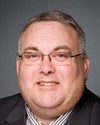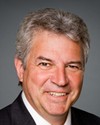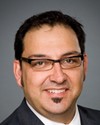We could offer you no more information than that, and what I've already shared. I think it has to stand on what it is, as we've allowed testimony to stand as it's been given.
Who do I have on my list? Mr. Reid.
Evidence of meeting #76 for Procedure and House Affairs in the 41st Parliament, 1st session. (The original version is on Parliament’s site, as are the minutes.) The winning word was proposal.
A recording is available from Parliament.
Conservative

The Chair Conservative Joe Preston
We could offer you no more information than that, and what I've already shared. I think it has to stand on what it is, as we've allowed testimony to stand as it's been given.
Who do I have on my list? Mr. Reid.
Conservative

Scott Reid Conservative Lanark—Frontenac—Lennox and Addington, ON
I just did the thing I was going to do.
Conservative
Conservative

The Chair Conservative Joe Preston
Does anyone else have a short question for our two witnesses before we excuse them?
All right.
Mr. Sullivan, Mr. Adler, thank you for coming and making your points today. It's been very helpful to us.
We will suspend for a minute or two while we get our next panel.
Conservative

The Chair Conservative Joe Preston
We will resume our study of the electoral redistribution of the province of Ontario. Welcome to all our guests this morning.
Mr. Hayes, I understand that you got out of your other committee to make it here. They know which committees are more important around this place.
It's good to have you all here. You will each get five minutes worth to tell us your story, and then we'll ask you very tough questions about it.
Mr. Hayes, you're going first this morning.
Conservative
Conservative

Bryan Hayes Conservative Sault Ste. Marie, ON
The initial report of the electoral boundaries commission proposed no changes to my riding of Sault Ste. Marie. That was anticipated. There should not have been any changes to my riding of Sault Ste. Marie. The population was 89,000, which is well below the provincial quotient already.
The final report of the boundaries commission proposed changes to the riding of Sault Ste. Marie and reversed almost every other recommendation it had initially made with respect to Sudbury, Timmins—James Bay, Algoma—Manitoulin—Kapuskasing, and Nipissing-Timiskaming.
The reasons for the reversal of those changes were really twofold. The commission determined that, based on consultations in those communities, there was no longer a community of interest. That was evident in Sudbury, Timmins—James Bay, Algoma—Manitoulin—Kapuskasing, and North Bay, and they also stated that there was inappropriate involvement by two members of Parliament.
A quotation from the report plainly and simply stated:
The advice received at those public hearings, combined with the inappropriate involvement of at least two Members of Parliament, persuaded the Commission to conclude that the status quo, with a few minor boundary adjustments, is the best solution it can achieve for Northern Ontario.
One of those minor boundary adjustments was to remove a portion of the riding of Sault Ste. Marie and place it within the riding of Algoma—Manitoulin—Kapuskasing.
Based on doing that, a hearing was conducted in Sault Ste. Marie. That was probably the final hearing that was conducted. It was thrown together fairly hastily, and it was done on a Monday morning, as I recall, at 11 o'clock. I think there were 12 people in attendance at the hearing. It was very clear from those in attendance that they do not agree that their community of interest falls along Highway 17. It's very clear, and they were very persuasive that their community of interest is in fact Sault Ste. Marie, without a doubt. Many of them commute to Sault Ste. Marie. They do their banking in Sault Ste. Marie. They do their shopping in Sault Ste. Marie. They work in Sault Ste. Marie at Essar Steel Algoma and various other employers.
I should point out that those people in attendance were representing other individuals as well. They were there representing people who couldn't come. It's my understanding that there were petitions presented, stating that they want to remain in the riding of Sault Ste. Marie. There were resolutions passed by three municipal townships, stating that they wanted to stay within the riding of Sault Ste. Marie.
It was not political at all. I might add that one of the resolutions came from Jody Wildman of St. Joseph Island, who is the reeve of that part of the Island. He is a well-known NDP supporter. His father, Bud Wildman, was the member of provincial parliament for the longest time. This is not political in any way, shape, or form. He himself said that St. Joseph Island should remain as part of the riding of Sault Ste. Marie.
The second point I want to make is just in terms of service to constituents. All these places that are removed are within a 40-minute drive of Sault Ste. Marie. The way it's happening now, if they have to become a part of the riding of Algoma—Manitoulin—Kapuskasing, whose riding office is housed in Elliot Lake, the result will be an-hour-and-a-half to two-hour drive for many of these constituents to go to a constituency office, when many of them are in Sault Ste. Marie on a weekly basis as it stands.
My final argument is that, if the commission allows this to move forward after it has openly recognized that there was inappropriate involvement by two members of Parliament, it is condoning that involvement and in fact rewarding it, which to me is an insult to those constituents in the riding of Sault Ste. Marie who are presenting the exact same arguments that the other ridings presented in terms of community of interest. The boundary commission is refusing to accept the community of interest argument in the riding of Sault Ste. Marie, but it is in the others.
In terms of a solution, I believe a much better solution, given the geographic size of Algoma—Manitoulin—Kapuskasing at approximately 100,000 square kilometres, is for the commission to invoke the extraordinary circumstances rule in the act to accommodate a population below the maximum negative variance from the provincial quota, similar to what it has done in many ridings, including Kenora. That is a much more reasonable approach, and that is the solution I propose.
Thank you, Mr. Chair.
NDP

Carol Hughes NDP Algoma—Manitoulin—Kapuskasing, ON
Bonjour. Thank you for the opportunity to appear before you to speak. During the electoral boundary process, I attended both meetings, one in North Bay on the original proposal and the second in Sault Ste. Marie, which was added after the commission put forward an alternative proposal.
I am certain it was a difficult task for the commission to create riding boundaries for northern Ontario that make mathematical and geographic sense. The need to draw up a second proposal reflects how challenging that was.
The physical geography and population density have to be balanced by what can reasonably be expected of any single member of Parliament, and what level of representation can be seen as the most balanced and fair for constituents. That means that in northern Ontario the boundary commission was not able to look only at numbers, as is possible in truly urban areas.
I brought to the commission a schedule of the outreach clinics my office runs so that people who prefer to approach their MP for help in person can do so, and showed how the placement of my constituency offices help maximize my ability to service the constituency. I have one here that I will be able to submit afterwards.
I believe the commission listened to the concerns and opinions presented to them, and the recommendations put forward show that they have done a good job of balancing the criteria. Additionally, they managed to maintain a semblance of continuity that will help minimize confusion among constituents across the region.
I understand there are people on both sides of this proposal, but I feel that if the overarching desire is to increase the number of voters in AMK, the final recommendation is the proposal that will likely do the least harm.
The changes made by the commission mean that the north shore boundaries of the riding of Algoma—Manitoulin—Kapuskasing more closely match the boundaries of the provincial Algoma-Manitoulin constituency along the north shore area.
I would also like to mention that from the beginning of the process, before I met with the commission, I was in touch with constituents and municipal officials to determine the wishes of the people who would be affected. Throughout my presentations to the commission, I encouraged them to maintain the status quo and grant a population exemption to AMK.
Given its current size and distance, the end results have to ensure that ridings be designed with serviceability in mind and fairness for constituents. I do believe it is important for the decision to reflect that Algoma—Manitoulin—Kapuskasing is made up of numerous similar-sized communities and beholden to none of northern Ontario's biggest cities.
This was the reason cited when the riding was created during the last round of redistribution, and it still makes sense today. It works to the advantage of the many small towns that receive equal representation under the current boundaries, which could be jeopardized if the riding were to skirt Sudbury as was originally proposed. This would also have put three members of Parliament in the city of Greater Sudbury, which would disadvantage the small communities, as I mentioned.
In conclusion I believe it is important to adopt a different mindset when considering the distribution of ridings in northern Ontario. We have to acknowledge that there is more to consider than mere population, and reflect how physical geography sets out certain challenges that define the ability of an MP to service a constituency.
It should also be noted that I did discuss the possibilities of boundary changes with the member from Sault Ste. Marie prior to the North Bay hearing, and did speak with him again after the Sault Ste. Marie one, given that he was not in attendance at either of them. I also suggested that he might want to make a submission. I'm not sure if he did that.
Finally it is important for this committee to consider the fact that any changes to Algoma—Manitoulin—Kapuskasing will cascade in two directions and cause considerable reorganization of constituency boundaries from the north shore of Lake Superior through to the Quebec boundary.
I urge you to weigh all these elements as you come up with your final recommendation.
Is there any more time?
Conservative

The Chair Conservative Joe Preston
Super. Thank you very much.
Monsieur Thibeault, you have five minutes.
NDP

Glenn Thibeault NDP Sudbury, ON
Thank you, Mr. Chair.
Thank you to the members of the committee for giving me the opportunity to come forward today and speak to the proposed boundaries for northeastern Ontario.
As you may be aware, when this process started last year the chief concern of the majority of northern Ontarians was keeping 10 federal ridings in the north. Northern Ontario represents 87% of Ontario's land area. So although the population of the ridings in the region is below the national average, it is important to keep 10 ridings in order to ensure effective representation.
I will use my own riding of Sudbury as an example of why this is so important. Although Sudbury is the largest city in northern Ontario, it has no passport office, and recently the CIC office in Sudbury was closed. This means that my office acts as a de facto immigration office and processes thousands of passport applications each year. So MPs in northern Ontario form a vital link between Canadians and the federal government, regardless of which party we represent.
I was therefore very happy that the proposal released by the Ontario commission in the fall of 2012 took this into account and kept 10 ridings in northern Ontario. However, there were a number of concerns with where the riding boundaries had been placed in the initial proposal, particularly in northeastern Ontario.
For example, the removal of Lively, Whitefish, and Naughton from the Sudbury riding did not reflect the fact that these communities are part of the city of Greater Sudbury, and it would have isolated them from the rest of the proposed Algoma—Manitoulin—Killarney riding.
The boundary between Timmins—Cochrane—James Bay and Nickel Belt—Timiskaming would have created an artificial divide between a community of interest of farmers and people associated with agriculture. The ridings of Timmins—Cochrane—James Bay and Nickel Belt—Timiskaming would have become larger both in terms of geography and population than the large ridings they replaced, making them almost unserviceable.
The removal of the Kapuskasing-Hearst region from the riding of Algoma—Manitoulin—Killarney would have placed it in a riding in which it had no political or community history.
The commission held public hearings in Sudbury, New Liskeard, North Bay, as well as Kenora and Thunder Bay. MPs from those areas all attended. The commission also offered a second round of public meetings in Sault Ste Marie to look at other options, and I would like to thank the commission for doing so. I also note that Mr. Hayes did not appear at any of these public hearings, even when changes were suggested to the rural region that is part of the Algoma provincial riding.
In each of these hearings, in northeastern Ontario it was clear that an overwhelming majority of constituents did not feel that the proposal put forward would provide representation equal to or better than the status quo. We thank the commission for listening to the citizens and mayors of northeastern Ontario regarding the problems that the original proposal would have created for the region.
The final report of the commission corrects the majority of these concerns, and as the report itself states, the final recommendation was made on account of the advice received at those public hearings. The NDP MPs in the region participated in the public hearing process within the guidelines drawn up in the 2004 report by Elections Canada, which lays out the rights of MPs to participate in the public hearing process. These read:
Members of the House of Commons are not by any means excluded from this process of public involvement. Indeed, it is recognized that they will invariably have strong views on both the names and boundaries of the proposed electoral districts. Therefore, members of the House of Commons are not only allowed to appear before a commission at the public hearings, but the legislation also provides the opportunity for them to object to the proposals of any of the boundaries commissions.
Any changes to boundaries in the region will have a significant knock-on effect on all ridings in northern Ontario. Let me repeat that: Any changes to the boundaries in the region of northern Ontario will have cascading effects that will affect the area from White River—north of Lake Superior—to the Quebec boundary. I therefore support the report of the boundary commission and would ask this committee to call for no changes to the boundaries for northern Ontario.
I thank, again, the boundary commission for their excellent work in what can be sometimes a thankless and difficult task, especially when you're looking at northern Ontario. And I thank you all for having me here today.
Conservative

The Chair Conservative Joe Preston
Thank you, Mr. Thibeault.
Mr. Angus, for five minutes, if you would, please.
NDP

Charlie Angus NDP Timmins—James Bay, ON
Thank you, Mr. Chair.
I'm pleased to be here today to speak to the boundary proposal to move the rural townships of Harris and Hudson into Timmins—James Bay. The move reflects the opinions that were given at the public hearing held in New Liskeard on October 15, 2012, on the need to maintain the continuity of rural communities along the Highway 11 corridor.
I support the boundaries commission's recommendation for this change. However, I have spoken with the member for Nipissing—Timiskaming about his desire to keep these townships within the present boundaries. I will defer to the boundaries commission either way on these matters and will be satisfied with the result.
I am also here, however, in response to Mr. Hayes' claim that political interference in the boundaries commission has unfairly impacted his region. Mr. Hayes is referring to references made in the federal electoral boundaries commission report for Ontario of February 23, 2013, where the commission referenced two examples of alleged inappropriate actions on my part.
The first was this:
The Member of Parliament for Timmins—James Bay submitted that the community of interest among farmers and people associated with agriculture in the farming area west and north of the City of Temiskaming Shores flowed north along Highway 11, and that there was no community of interest with people involved in agriculture in the electoral district of Nickel Belt.
My involvement was in the form of a public hearing in New Liskeard, where I read a statement into the record. I will quote from the record of what I stated that day:
Cutting a line through Timiskaming will be very detrimental. This will be the third time in just over 10 years that Timiskaming has been substantially affected by dramatic riding changes.... Under the new changes, the line has been arbitrarily moved vertically along Highway 11 so that Englehart will now be in the Nickel Belt riding, while its neighbouring community of Tomstown will be in Timmins—Cochrane—James Bay.
Thus, residents in one community will be a 20-minute drive from their MP office, while their neighbours are 300 km from their MP.... It makes no sense from a geographic or economic point of view.
Moving Timiskaming into Nickel Belt will create numerous problems for the agriculture community of Timiskaming. There are no historic or economic lines of continuity between rural Timiskaming and the Sudbury region.... People in Nickel Belt overwhelmingly see themselves as part of the greater Sudbury region. Timiskaming, however, is part of a growing farm community that is anchored on Highway 11.
The second objection that the boundaries commission referenced as inappropriate actions was also stated in the report:
The member also expressed concern about the ability to serve constituents effectively if the communities along Highway 11 from the Town of Smooth Rock Falls to west of the Town of Hearst were included in the electoral district.
I will therefore read the statement that I gave to the commission:
I know it is not the mandate of the boundaries commission to concern itself with MP staffing and budgets. However, the boundaries commission needs to reflect on the impact of an additional six communities, some as much as 300 km from our existing office, being added to the riding. As no other ridings in the north other than Nickel Belt—Timiskaming are being asked to assume such dramatic new responsibilities, I argue that this recommendation creates an unnecessary imbalance between the smaller urban ridings and the larger rural ridings.
The riding of Timmins—James Bay is already bigger than Great Britain. The northwest rural riding of Kenora has a population that is 40% less than the proposed Timmins—Cochrane—James Bay riding. The new Nipissing riding will have a population that is 11% smaller than the new riding and a land mass that is a mere 4% of the size of my expanded riding. The urban riding of Sudbury will have a population smaller than Timmins—Cochrane—James Bay, while my riding is being asked to assume 17,000 more kilometres of distance and six new communities. There is no reason for such obvious disparities within the ridings of northern Ontario.
The position that I presented was echoed by over 1,000 submissions of citizens, town councils, and municipal organizations. Justice Valin and his commission ultimately agreed with these objections. I am satisfied that the new boundary proposal represents the larger interests of citizens in our region, and that further changes at this late hour would only create a ripple effect across a number of ridings.
I thank the boundaries commission for its excellent work. It is a hard task to fix the issues in northern Ontario, and people were certainly vocal in responding to the problem, with their initial proposals. However, the true test of fairness is noted in the commission's willingness to listen to the issues and attempt to find a balance, given the problems of the vast geography of northern Ontario. I support its recommendations.
Conservative

Jay Aspin Conservative Nipissing—Timiskaming, ON
Thank you, Chair. I'd like to thank the members of the committee. It's a pleasure to be here with my northern colleagues today.
My recommendation is very simple. I'll give you a little background. Under the first proposal, essentially my riding of Nipissing—Timiskaming was cut in half and it was proposed that the Timiskaming portion be realigned with Nickel Belt. As others have indicated, this caused considerable consternation. That portion of Timiskaming has always been aligned with the Highway 11 corridor, and that was the major objective I received as well.
Under the second proposal, everything was moved back from Nickel Belt to my riding—everything except the northern border. By the northern border, I submit that the townships of Harris, Hudson, and several unincorporated townships.... When I talked to residents in that portion, several people approached me and mentioned two factors. They are aligned with the Highway 11 corridor, and further, they are aligned with Temiskaming Shores. That's really their community of interest.
As Mr. Thibeault has pointed out, it's more or less the situation of Lively to Sudbury. It's the same situation in these cases. They're very small townships but, nonetheless, their community of interest is Temiskaming Shores. So it's very simple, Mr. Chairman. All I'm saying is that not everything was put back; indeed, those particular townships weren't put back. In accordance with the wishes of the residents, I am requesting that they be put back. I took it upon myself to call the reeves of the two townships, and they concurred. I had a discussion with Mr. Angus, who indicated that he doesn't have a problem with it, so I'm asking that this portion be reallocated to Nipissing—Timiskaming.
As for participation, Chair, call it naïveté on the part of a first-time member, but during the first proposals I thought that we as MPs were to stand back and let the public provide the input. As MP Hayes has indicated, that's why I stood back and didn't comment. I let the people comment.
With this second proposal, I'm here to convey the wishes of the residents that they would like to realign. So it's very simple: just put back the townships, and I'd be happy.
Thank you, Mr. Chair.
Conservative
Conservative

Scott Reid Conservative Lanark—Frontenac—Lennox and Addington, ON
Thank you, Mr. Chair.
I noted that two of the commentators, Mr. Thibeault and Ms. Hughes, both observed that Mr. Hayes had not been present at the earlier round of hearings. I gather there was an interim round with that special Sault Ste. Marie meeting.
You didn't say it outright, but I got the sense from the subtext there that because Mr. Hayes had failed to be present at that time, his testimony today should be given less weight as a consequence. Is that what you're saying? Either of you can answer or both, if you wish, but don't take too long.
NDP

Carol Hughes NDP Algoma—Manitoulin—Kapuskasing, ON
That's not what I'm saying at all.
I indicated I had a discussion with Mr. Hayes about the changes. When it came to North Bay, Mr. Hayes said that there were no changes to his riding, so he had no interest in being there, and I only spoke to him afterwards with respect to Sault Ste. Marie. I assumed he would be there because it was in his own backyard, and I don't know the reasons why he wasn't there.
As I said, he could have made a submission. I have no idea if he did or not. So I indicated I did attempt to be there. I did speak to Mr. Hayes prior to going to North Bay, looking at a better solution because I knew that the changes that were being proposed did not align properly with the riding, and he indicated that he wanted to keep St. Joseph Island because his best man was from there.
I can tell you that I did speak to some of the mayors on St. Joseph Island.
Conservative

Scott Reid Conservative Lanark—Frontenac—Lennox and Addington, ON
That's great. Just hang on a second, Ms. Hughes. The question I asked you was whether you had felt that his testimony should be given less weight on this account—
Conservative

Scott Reid Conservative Lanark—Frontenac—Lennox and Addington, ON
And you answered that. I'm glad you said that. I just wanted to get that confirmation.
Mr. Thibeault, do you concur with her on that point?